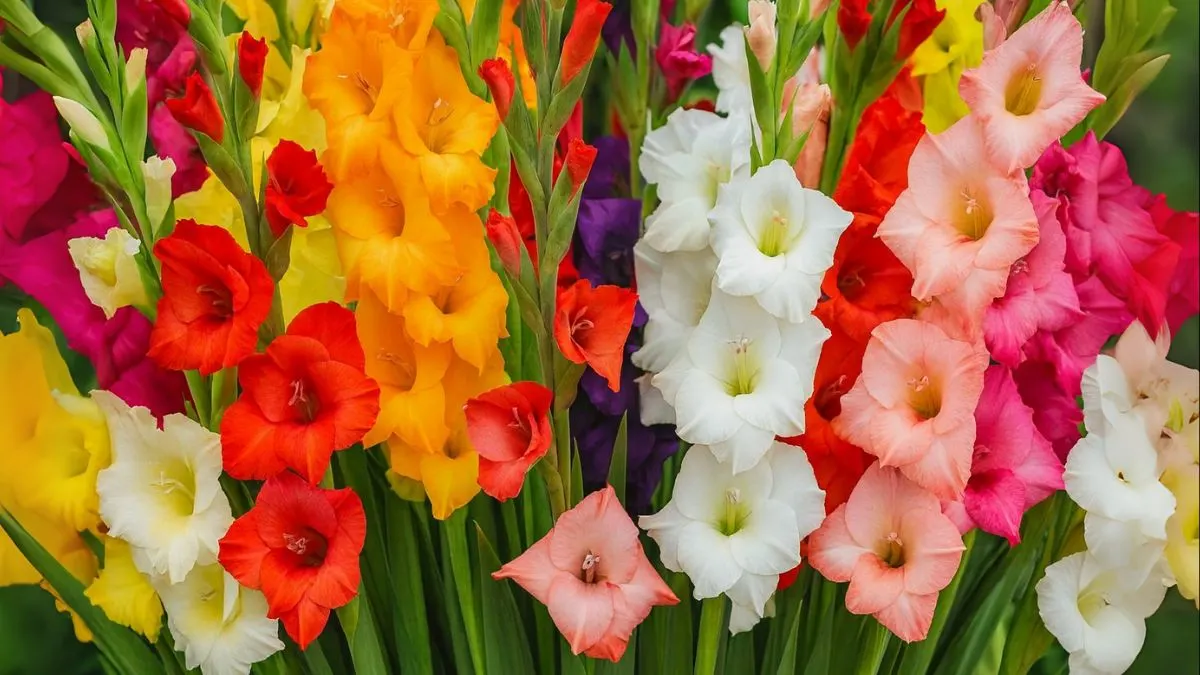Gladiolus, often called the “sword lily,” is a gardener’s favourite for its tall spikes of vibrant flowers. These beauties are perfect for borders, cut flower arrangements, and adding drama to any landscape. With a little planning and care, anyone can enjoy their striking blooms from summer into autumn.
Why Choose Gladiolus?

- They produce long-lasting, colorful flowers that brighten gardens worldwide.
- Easy to grow in Canada, the USA, and across temperate regions.
- Perfect for cut flowers—florists love their tall, showy spikes.
- Multiple planting times mean extended flowering seasons.
When I first tried growing them, I was amazed by how a few small corms transformed my dull backyard corner into a vibrant display of pinks and purples.
Choosing the Right Spot
Gladiolus thrive in sunny spots.
- Plant glads in full sun (6 to 8 hours of sunlight per day).
- They perform best when planted in a spot with full sun, in rich and well-draining soil.
- Shelter them from strong winds that may topple their tall stems.
If you’re gardening in cooler regions, make sure your site gets maximum sunlight for best blooms.
Also Read: Petunias: The Flower That Turns Any Balcony Into a Blooming Paradise
Soil Preparation
Soil plays a crucial role in healthy growth.
- Grow gladioli in moist but well-drained soil in full sun.
- Amend clay-heavy soil with sand or compost to improve drainage.
- Loamy, slightly acidic to neutral soil (pH 6.5–7.0) works best.
Adding a layer of compost not only nourishes the corms but also keeps the soil airy and moisture-balanced.
When to Plant Gladiolus
Gladiolus can be planted in both spring and autumn depending on your climate:
- Plant gladiolus corms in spring 2 weeks before your last expected frost date.
- In milder regions, you can also plant gladiolus corms in autumn for early spring blooms.
- To extend the flowering season, stagger plantings every two weeks during spring and early summer.
How to Plant Gladiolus Corms
- Dig holes 4–6 inches deep.
- Space corms 6 inches apart for good airflow.
- Place corms with pointed ends facing up.
- Cover with soil and water well.
For continuous flowering, plant groups of corms in succession rather than all at once.
Also Read: How the Insulin Plant Could Be a Game-Changer in Your Garden
Watering and Care
- Water deeply once a week, ensuring soil remains moist but not soggy.
- Mulch around plants to retain moisture and suppress weeds.
- Tall varieties often need staking to prevent stems from bending.
During my first season, I skipped mulching, and weeds quickly took over. Once I added mulch, maintenance became much easier, and the flowers thrived.
Fertilizing Gladiolus
- Apply a balanced fertilizer (10-10-10) at planting.
- Add another feed when flower spikes appear.
- Avoid excessive nitrogen, which produces leaves instead of blooms.
Harvesting Gladiolus Flowers
Gladiolus make excellent cut flowers.
- Cut spikes when the first flower on the stem begins to open.
- Use sharp shears and cut early in the morning for freshness.
- Leave at least 4 leaves on the plant to nourish the corm for next year.
Seasonal Aftercare
- After flowering, allow foliage to yellow before cutting back.
- In colder climates, dig up corms before frost.
- Store them in a cool, dry place until the next planting season.
Also Read: Sahadevi Plant: The Hidden Vastu Herb That Attracts Positivity & Healing
Key Requirements for Growing Gladiolus
Requirement |
Details |
Sunlight |
Plant glads in full sun (6 to 8 hours of sunlight per day) |
Soil |
Planted in a spot with full sun, in rich and well-draining soil |
Planting Time |
Plant gladiolus corms in spring 2 weeks before your last expected frost date or plant gladiolus corms in autumn |
Soil Moisture |
Grow gladioli in moist but well-drained soil in full sun |
Fertilization |
Balanced feed at planting, repeat during flowering |
Common Mistakes to Avoid
- Planting in shaded spots reduces flowering.
- Overwatering leads to corm rot.
- Forgetting to stake tall varieties results in drooping flowers.
- Planting all corms at once shortens the blooming season.
Personal Experience
One year, I planted all my corms in early spring and enjoyed a spectacular bloom in June. However, the garden looked bare later in summer. The following season, I staggered plantings every two weeks. That small adjustment gave me flowers for almost three months straight!
Gladiolus are among the most rewarding flowering plants for any home garden. With the right care and steps your garden can be filled with colorful gladiolus spikes that add elegance to borders, beds, and bouquets.






